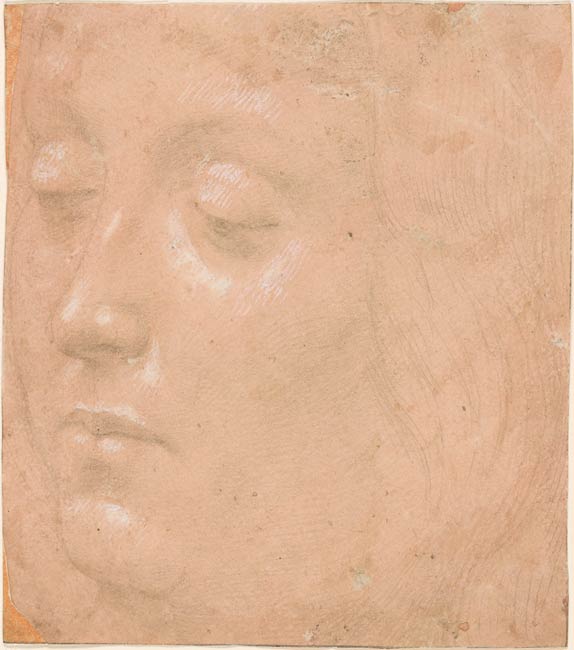
Lo renzo di Credi was the son of a goldsmith, but he seems to have received his training as a painter in the workshop of Andrea Verrocchio. He eventually became one of Verrocchio’s most trusted assistants, even taking over the workshop when Verrocchio moved to Venice in 1480. Credi has been overshadowed in the history of art by Leonardo da Vinci, his fellow pupil under Verrocchio, but Credi was a consummate and meticulous craftsman, a successful painter especially of devotional panels and portraits, and he enjoyed a long career lasting into the 1520s. He was also responsible for training many artists of the next generation—Fra Bartolommeo (see I, 28; 1957.18; and IV, 11) perhaps foremost among them1—and he was a traditional but refined draftsman.
The Head of a Youth is one of a large body of drawings by Credi that depict heads, both male and female, young and old, in metalpoint with white heightening on tinted, prepared paper.2 Among the many comparable examples are the Veiled Head of a Woman in the Uffizi3 and a group of drawings in the Louvre.4 These drawings share with the Morgan sheet both physiognomic features such as the swollen eyelids and mouth as well as the artist’s tendency to delineate these with distinctive patterns of highlighting under the eyes, below the corners of the nose, and on the chin. The reserved, quiet air of the subject, emphasized by a glance downward and away from the viewer, is another common motif in Credi’s work.
Relatively few of these drawings correspond directly to figures in Credi’s paintings, suggesting that they were made not as preparatory works but rather as something more like traditional model book or sketchbook drawings. Nonetheless, one can certainly find many similar facial types in Credi’s finished works. In their gentle shading, the drawings are less sculptural than are Verrocchio’s own head studies, but that delicate refinement is typical of Credi’s artistic outlook. Vasari described Credi’s paintings as “so finished and polished that all other paintings, in comparison with this, seem like rough, dirty sketches by comparison.”5 His drawings, though lacking the plasticity of Verrocchio’s or the technical and conceptual innovations of drawings by Leonardo, Filippino Lippi (see II, 72 and II, 73; 1951.1), and other contemporary Florentines, could be described in similar terms. —JJM
Footnotes:
- See Everett Fahy in Florence 1996, 6–7.
- The drawing was not included in Dalli Regoli 1966, the standard catalogue of Credi’s works, but it is so typical of the artist that the attribution is secure. Dalli Regoli’s work was published in 1966, but it relies upon research undertaken for the author’s 1959 thesis; given that Scholz had only acquired the drawing in the early 1950s, it seems that Dalli Regoli was simply unaware of the sheet.
- Gabinetto Disegni e Stampe degli Uffizi, Florence, inv. 1195e. See London and Florence 2010–11, no. 42.
- See Paris 2003, nos. 30–37; inv. 1779–83,1784E, 2675–76.
- Vasari 1878–85, 4:569.
Watermark: none.
Inscribed on verso, in graphite, "Lorenzo di Credi/ Coll. Liechtenstein".
Lichtenstein, former owner.
Scholz, János, former owner.
Rhoda Eitel-Porter and and John Marciari, Italian Renaissance Drawings at the Morgan Library & Museum, New York, 2019, no. 27.
Selected references: Montreal 1953, no. 30; Bloomington and elsewhere 1958, no. 15; Newark 1960, no. 8; Berenson 1961, 2: no. 701A; Oakland and Berkeley 1961, no. 28; Cologne 1963-64, no. 44; New Haven 1964, no. 6; Los Angeles and Seattle 1967, no. 13; London and elsewhere 1968, no. 27; New York 1971, no. 28; Scholz 1976, no. 10; Notre Dame 1980, no. 137; Fellows Report 19 1981, 185; Lawrence 1986, no. 14.
Italian Drawings from the Collection of János Scholz. London : Art Council Gallery, 1968, no. 27.
One Hundred Italian Drawings from the 14th to the 18th Centuries from the János Scholz Collection. New York : New School Art Center, 1971, p. 28.
Scholz, János. Italian Master Drawings, 1350-1800, from the János Scholz Collection. New York : Dover, 1976, no. 10, repr.
Scholz, János, and Dean A. Porter. János Scholz, Musician and Collector. Notre Dame : Snite Museum of Art, University of Notre Dame, 1980, no. 137.
Ryskamp, Charles, ed. Nineteenth Report to the Fellows of the Pierpont Morgan Library, 1978-1980. New York : Pierpont Morgan Library, 1981, p. 185.
